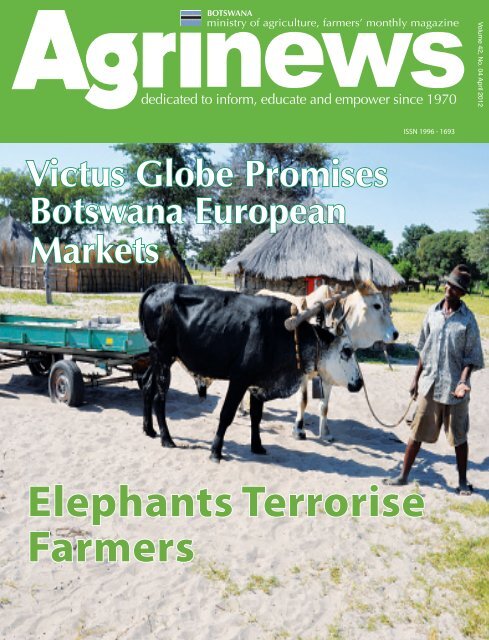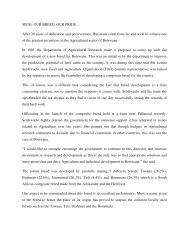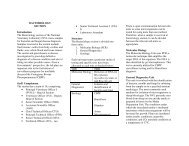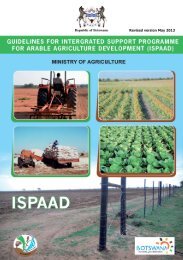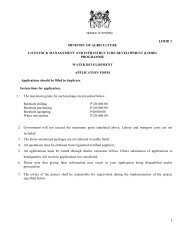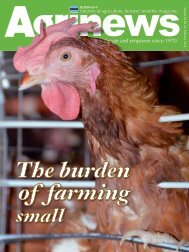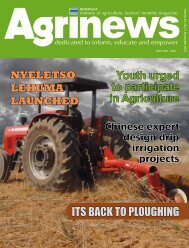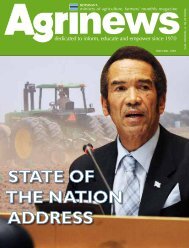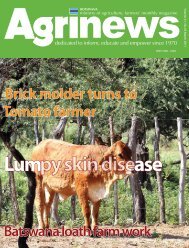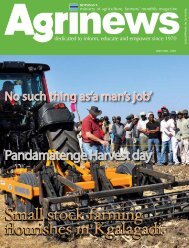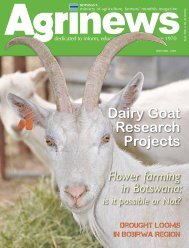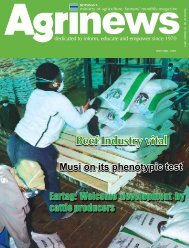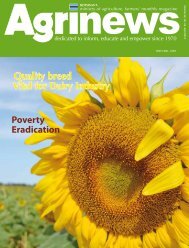April 2012.indd - Ministry of Agriculture
April 2012.indd - Ministry of Agriculture
April 2012.indd - Ministry of Agriculture
- No tags were found...
You also want an ePaper? Increase the reach of your titles
YUMPU automatically turns print PDFs into web optimized ePapers that Google loves.
<strong>April</strong> 2012
VISIONFOUNDATIONPILLARSAttain national food securityand global competitivenessin agricultural productseditor’s noteLET US DIVERSIFY THROUGH HORTICULTUREMISSIONTo improve agricultural productivitythrough technology developmentand transfer, diversification andcommercialization, in orderto promote food security inpartnership with our stakeholders.VALUES1. BOTHOWe treat our customers ina respectable and caring manner.2. TEAM WORKWe recognize the need to work asa team characterized by collectiveeffort, trust, understanding,support and perseveranceirrespective <strong>of</strong> rank or gender.3. CUSTOMER FOCUSEDOur customers are the focus<strong>of</strong> everything we do by beingcourteous, caring, compassionate,tolerant and empathetic.4. INNOVATIVEWe commit to employ new ideasand being proactive in order tomatch the requirements <strong>of</strong> thefuture.5. INTEGRITYWe foster a culture <strong>of</strong> transparency,accountability and dependability.The Integrated Support Programmef o r A r a b l e A g r i c u l t u r a lDevelopment (ISPAAD) has acomponent for horticulture. Throughthe component, the government isdetermined to bring a lease <strong>of</strong> life tothe agricultural sub-sector, which to acertain extend is struggling.It is still worrying to learn that thissub-sector still relies heavily on imports.The high import bill for horticulturalproduce clearly shows the nation’s highappetite for such produce. Just like beef,it is part <strong>of</strong> our daily dish.It is the believe <strong>of</strong> this publication thatthose in the horticulture sub-sector canwork extra hard to make Our Botswanaa paragon <strong>of</strong> horticulture produce. Wecan, just like our success story in thebeef industry.This is a sector, which we believe, cancontribute significantly to economicdiversification. The sub-sectorcontributes to employment creationjudging by amongst others, the number<strong>of</strong> horticultural vendors.However, those in local productionare unable to sustain their marketbecause the supply is always punctuatedby lack <strong>of</strong> produce.At the time the farmer is still waitingfor maturity <strong>of</strong> vegetables where is theretailer? It is justifiable for the retailer tolook elsewhere, because he/she is dutybound to meet the consumer’s need.Horticulture farmers cannot afford tointerrupt the flow chain. That is why theretailer looks else where to grease thischain to maintain the customer base.In order to avert such a situation, localfarmers should up their game to be atpar with the fresh produce demand.We have to work hard to ensurethat we reduce the import bill forhorticultural produce. The time is nowas tomorrow might be very far for thecountry to become self sufficient inhorticultural production.Such farmers must also note that therecan be diversity in the horticulturalsector. Some can grow potatoes, lettuce,cabbage, etc. The sector is not onlyabout production <strong>of</strong> spinach and rape.Let us work toward diversification <strong>of</strong>our produce.It is our wish and dream to one daybecome a major exporter <strong>of</strong> one <strong>of</strong> thehorticultural produce. It can be done aswe have done with our beef which hasfound itself in the kitchen <strong>of</strong> EuropeanUnion citizens.i<strong>April</strong> 2012
MAN ENJOYS 32 YEARS OFORCHARD BUSINESSArticle: Segomotso BasutiPhotos: Aggripah WillieAs people moved from one placeto another in search <strong>of</strong> betterliving so did Otimile Joseph.It was in 1980 when he relocatedto Shakawe from Maun looking forsomething that would put food on histable. At 20, he scanned the village t<strong>of</strong>ind out what the village can <strong>of</strong>fer andsettled for an orchard.He started making trials on whetheror not the business was viable. Thebusiness began on a low pace. Herealized that for him, horticulture wasa difficult thing to embark on especiallyin an area where people were not veryfamiliar with the growing <strong>of</strong> fruits andvegetables.Therefore, he started with a handful<strong>of</strong> trees due to meagre funds. As yearswent by both his business and marketstarted to grow.It was at this time that he knew therewas no turning back. Up to now, he isa fervent grower <strong>of</strong> fruits and vegetables.Starting with zero knowledge <strong>of</strong>agriculture, Joseph is an epitome <strong>of</strong>dedication to be an expert at a particularfield. Joseph has so far expanded hisknowledge on running his businessby acquiring pr<strong>of</strong>essional assistancethrough means <strong>of</strong> a series <strong>of</strong> shortcourses, he attended in Maun fromtime to time. One may wonder whyhis interest in orchard business whenmost people in his area take dry landfarming to heart.“I felt the urge to start the orchardwhen I realized there was a serious lack<strong>of</strong> fruits and vegetables in my area.”This has changed over the yearsas people are starting to realize theimportance <strong>of</strong> healthy eating. Everybusiness person’s number one goal is toOtimile Joseph in his orchardsee his business blossom. Joseph is notan exception. At the moment, he is onthe lookout for any new markets. He isalso looking out for ways to broaden hisbusiness to make more money.Joseph does not operate his businesson a lay man’s terms, but by the books inorder to monitor whether he is runningat a pr<strong>of</strong>it or loss.Horticulture is a demanding businessin terms <strong>of</strong> equipment needed to getit going. Water has <strong>of</strong>ten proved achallenge and a reason most projectsdid not stand the test <strong>of</strong> time. Peoplelike Joseph, however, count themselveslucky as his project is situated just nearthe river bank, making water the least<strong>of</strong> his problems.“Lack <strong>of</strong> money is always a setback foran entrepreneur, how you try to keepyour head up is all that matters.”He started with mangoes and oranges,10 for each tree. As one enters hisorchard, the variety <strong>of</strong> fruits makes onesalivate.Connections with big shops suchas Choppies, gives him hope <strong>of</strong> abright future ahead. He is looking int<strong>of</strong>urthering his business by planting otherfruits and vegetables.<strong>April</strong> 2012 2
LIVESTOCK IMPROVEMENTACT 2009 CLOSES GAPMs KapeleArticle: Keamogetse BoitshepoPhotos: Keseg<strong>of</strong>etse TaweleFor the first time the livestockindustry in Botswana has anAct that regulates livestockimprovement activities. The Act makesprovision for the establishment <strong>of</strong> thelocal Stud Book Association, livestockbreeders’ societies as well as the AnimalProduction and Advisory Board.Joyce Kapele, Chief Scientific Officer,Department <strong>of</strong> Animal Production saysthe Act aims to address omissions andlimitations <strong>of</strong> the repealed Registration<strong>of</strong> Livestock Act (CAP 36:04) <strong>of</strong> 1921.“The Registration <strong>of</strong> Livestock Act(CAP 36:04) <strong>of</strong> 1921 only allowedBatswana to register their livestockwith the South African Stud Book,”she explained. As such, Kapele saidthe Act tackles lack <strong>of</strong> proper system<strong>of</strong> livestock registration by makingprovision for the establishment <strong>of</strong> thelocal Stud Book Association under theAct as an umbrella body for all livestockbreeders’ societies.The responsibility <strong>of</strong> the Stud BookAssociation is to capture data relatingto the pedigree and performance <strong>of</strong>animals. As well as ensure that datarecording and operation <strong>of</strong> livestockbreeders’ societies function accordingto international standards <strong>of</strong> AnimalRecording and Genetic Evaluation.The establishment <strong>of</strong> the Animalproduction and Advisory Board andlivestock breeders’ societies, Kapelenoted are intended to address lack <strong>of</strong> awell established institutional frameworkwhich regulates the utilization andmanagement <strong>of</strong> animal geneticresources.“The Board shall be a corporatebody with perpetual succession anda common seal, capable <strong>of</strong> suing andbeing sued.”She said the Board will be appointedby the Minister and consist <strong>of</strong> 10members from relevant governmentdepartments as well as otherstakeholders such as Botswana MeatCommission and farmers Associations.The main function <strong>of</strong> the Boardaccording to Kapele, will be <strong>of</strong>feringadvisory services to the Ministeron various issues relating to thedevelopment and improvement <strong>of</strong> thelivestock industry. Other matters, theBoard will advise on are establishment<strong>of</strong> schemes for improving the geneticproduction potential <strong>of</strong> livestock andpriorities in respect to research.Further, Kapele asserted that theMinister will appoint a Registrarwhose responsibility is to establish andmaintain a register <strong>of</strong> semen collectorsand collection centers, embryotransferors, artificial inseminationcenters and the livestock breeders’societies among others.For his part, the Chief ExecutiveOfficer <strong>of</strong> Botswana Meat Commission(BMC), Dr David Falepau said properlystrategized implementation plan <strong>of</strong> theAct has potential to make Botswana thebest in the world at producing animals<strong>of</strong> good genetic quality.“The implementation <strong>of</strong> this Act iscritical because for the first time it willbecome possible to register local breedsocieties and schemes for monitoringthe performance <strong>of</strong> breeds.”Falepau celebrated that the Act willend importation <strong>of</strong> Mr genetic Tlhabiwe materialfrom regional countries that prevailedfor a long time.“This is bound to change as this Actwill position the local industry toproduce and identify animals <strong>of</strong> highgenetic merit that can be sold alive oras semen or embryos in the local andinternational markets.” Further, Falepausaid even though the BMC 2012to 2016 projections shows definitefinancial viability and sustainability <strong>of</strong>the beef supply chain, there is need toproduce good quality beef, on time andaccording to specification.“This requires , amongst other thingsanimals <strong>of</strong> the right genotypes that areselected for the most economicallyimportant traits such as fertility, growthrate, feed conversion efficiency, leanmeat yield and so on.”He ,however ,warned that livestockproductivity cannot be enhanced byincreasing the genetic potential alone,therefore urged for increase <strong>of</strong> othermanagement factors such as nutritionand husbandry.3<strong>April</strong> 2012
Dr PodisiDepartment <strong>of</strong> Agricultural Research.Only stud breeders who participated instage 1 (on farm evaluation) can enroll.Parameters evaluated include; postweaning growth rate, feed conversionratio (feed efficiency), body lengthand shoulder height (beefing capacity),scrotal circumference (breedingpotential).At the central performance testingcentre, data collected on animalsinclude feed take, average daily gain,feed conversion ratio, hip height,breeding soundness, rib eye area andintra mascular fat / back fat.Carcass evaluation stage involvesevaluation <strong>of</strong> carcass quality <strong>of</strong> progeny<strong>of</strong> bulls tested under stage 1 and 2.Evaluation is done at Meat InspectionTraining Centre (MITC) abattoir inLobatse. Carcass weight, dressing% fat%, muscle/bone ratio, meattenderness, marbling effect and leancolor are some <strong>of</strong> the traits evaluated.The scheme, however, encounteredseveral challenges like absence <strong>of</strong>statutory bodies (registrar, board)that led to low confidence aboutthe scheme, decline in number <strong>of</strong>farmers participating, Podisi stressedthat it is regrettable that there aremany animals out there but theyare not getting a desirable <strong>of</strong>f-take,inadequate manpower to monitordata collection on farm), transport andfunds to run the scheme and shortageor no database to manage the data.Lack <strong>of</strong> suitable structures at farm level(no breeding season, single sire mating,lack <strong>of</strong> handling facilities, weighingscales, poor record keeping, animalidentification), limited understanding <strong>of</strong>benefits <strong>of</strong> performance recording andlack <strong>of</strong> commitment by farmers.Sharing his experiences about thescheme, Mr Dikampa Hendricks, afarmer at Xanagas ranch in Ghanziexplained that when the scheme wasinaugurated in Ghanzi, he was a smallfarmer with as little as 40 herds. Hestressed a need to start with a littlenumber as it is an everyday job. Thecattle have to be monitored on a dailybasis(four hourly intervals for pregnantcows).“It is very important to keep therecords, I submit the records each yearafter seven months.” Hendricks addedthat most Batswana tend to leave theiranimals until they are uncountable butthe scheme helps a farmer to identifycattle one by one. The calves and theirmothers have to be tagged to make surethat each year the animals calf. Thisenables the farmer to cull those whichdo not calf.Hendricks urged other farmers toembrace the scheme.“I can assure you that it is good andhas returns. I sell high quality breedsfor lots <strong>of</strong> money.” Hendricks alsoexplained that record keeping is veryimportant in the sense that when buyingbulls either locally or internationally, afarmer should demand records <strong>of</strong> thebull and avoid instances <strong>of</strong> buying anunproductive bull (having no semen) byjust looking at its outside appearance.He urged the <strong>Ministry</strong> <strong>of</strong> <strong>Agriculture</strong> togive the scheme maximum exposure inthe line <strong>of</strong> television coverage, to givea demonstrative coverage on handlingand weighing newborn calves.One <strong>of</strong> the participants, Mr BlomLekoma <strong>of</strong> Goodhope said it is notpossible for them as farmers to keeprecords as most <strong>of</strong> them do not haveranches <strong>of</strong> their own,as they still relyon communal grazing land. He saysalthough they had long suggested to thegovernment to start up cluster fencing<strong>of</strong> communal grazing land, nothing isforthcoming.5<strong>April</strong> 2012
EX-MINER GETS NEWLEASE OF LIFEArticle: France BegenselPhotos: Aggripah WillieAgricultural production isalways at the back <strong>of</strong> everyman’s mind. Be it that theyare in the corporate world, mining,teaching or medical pr<strong>of</strong>ession.Some would keep a few animalswhile others would grow somevegetables in their backyards.For Johannes Sachangane ,54, <strong>of</strong>Saoshoko, life in the South Africanmines could not <strong>of</strong>fer him what hehad desired. For him, life in themines was a struggle, that is thereason he called it a day in 1981 toreturn home with nothing to showfor the years he spent there.“I had nothing to show for thetime and energy I invested, whenI returned. But at least I can nowshow that mahisa (Tswana traditionwhereby domestic animals; cattle,sheep,goats, etc, are given tosomeone, especially the poor, tolook after. The person is rewardedwith any one <strong>of</strong> the animals after acertain period <strong>of</strong> time, dependingon what was agreed upon) hasgiven me a new lease <strong>of</strong> life.”Sachangane was given mahisa inthe form <strong>of</strong> cattle by a certain manin the village. “These were cattle <strong>of</strong>different breeds; tswana, afrikander,brahman and a few charolois.” Hehas since progressed a lot from thetime he ot the animals.He is paid with a beast ever year.He is glad that he can now takecare <strong>of</strong> his family with milk andproceeds from selling it (milk). Theformer miner also uses the animalsas for draught power. “ I ploughedand planted my field using theseanimals because there are notractors in our village.”He is quick to point out that onecan prosper well in exotic breedsbecause <strong>of</strong> their big body structuresand weight, especially if you sellto the Botswana Meat Commission(BMC). He laments that for one toalso do well ,one must take goodcare <strong>of</strong> the cattle. “You must showthem you care by dipping themand vaccinating against diseasessuch as Lumpy skin, botulism andpasturella.” He posits though thatthe Foot and Mouth Disease is theirmain source <strong>of</strong> concern comparedto other diseases.Sachangane says their area is ared zone, therefore, their animalscannot be slaughtered and sold tothe Europen Market. A setback, hesays empoverished them, addingthat they are compelled to sell tomillers and butcheries at giveawayprices.The Saoshoko farmer grazeshis cattle in a communal area,decrying the lack <strong>of</strong> grazing lands.He says this is too much a concernbecause their cattle easily getdiseases and are <strong>of</strong>ten stolen oreaten by wild animals. He explainsthat despite this mishap there isplenty <strong>of</strong> water.The retired miner says it is noteasy go for his animals. He saysDichapetalum Cymosum, (Mogauin Tswana) is highly abundant inthe area. This has resulted in himloosing four animals after theyconsumed it. He adds that thisis a dangerous plant especially ifanimals drink water after eating it.He advices that if one realises thattheir cattle have eaten Mogau, theymust put them in the kraal at leastfor a day without drinking water.Sachangane advices otherfarmers in Okavango that eventhough their area is an FMD zone, they must not despair. He saysthey should continue raising cattleincase the situation changes in thefuture.Johannes Sachangane<strong>April</strong> 2012 6
Willieami in the44. The structure <strong>of</strong> the kraalhelps protect the goats fromharsh weather conditions5. Millet does well inNgamiland6. Traditional storagemethods still practised569<strong>April</strong> 2012
Maitseo DibebeWoman farmerArticle: France BegenselPhotos: Agripah Williemanuallyrow-plantsRaws <strong>of</strong> meandering lines<strong>of</strong> beans, groundnuts andmaize are testimony to what adedicated farmer Maitseo Dibebe is.The rows <strong>of</strong> crops fill the five hectorplanted field. All <strong>of</strong> these have beenplanted with hands and hoe (withoutusing a planter).As a demonstrator farmer, Dibebe,who was born in the 1930s, is adedicated farmer who has livedher life cultivating her field. Shehas always wanted to show people<strong>of</strong> Okavango that row planting ispr<strong>of</strong>itable compared to the oldways <strong>of</strong> broadcasting. She revealsthat she realised a good harvest inthe previous years. Last ploughingseason alone, she managed to get35 <strong>of</strong> 50kg bags <strong>of</strong> beans. Even afterher husband’s passing away, shenever folded her arms, but remaineddetermined to produce food herself.She decided to stand up and becomeexemplary <strong>of</strong> what it means to be ademonstrator farmer.She ploughs her field using oxendue to lack <strong>of</strong> tractors in her extensionarea. Dibebe uses a hand held hoe todig holes to insert seeds and that haspaid <strong>of</strong>f as she has not experiencedany problems with germination <strong>of</strong>the crops.Dibebe’s farm is used for pilotingseeds that are new in the area. Shehas currently planted a new variety<strong>of</strong> beans (hybrid IT18) that wasintroduced only last year by theDepartment <strong>of</strong> Agricultural Research(DAR). The variety is doing well andit has been extended to other farmersin Xhaoga and Nxamasere extensionarea.She discloses that dryland farmingdoes not come easy. She says lack<strong>of</strong> tractors in Nxamasere is a bigchallenge. Though, she uses draughtpower, she faces problems as she hasno one to assist her.The Xhaoga resident says elephantsare a menace to her crops but hasimprovised with the use <strong>of</strong> chillies.She says it has helped a lot becauseelephants are disgusted by its smell.She says the chillies is crushed andmixed with used oil or diesel, afterwhich the pieces <strong>of</strong> cloth are soakedin the mixture and hang on the fencearound the field.As for the market, she encounteredproblems in selling her produce.Last year, she hoped to sell to theBotswana Agricultural MarketingBoard (BAMB) in Maun but lack <strong>of</strong>transport was a major hinderance.Attempts to sell to schools also hit asnag as her produce failed the qualitytest for consumption in schools. She,however, sold and bartered some <strong>of</strong> itwith locals in exchange for produceshe did not have.The Agricultural Demostrator forNxamasere Extension area, MsBakang Autlwetse shared the samesentiments with her. She said most<strong>of</strong> subsistence farmers’ produce gotspoilt due to lack <strong>of</strong> transport to takeit to BAMB. She has since met withthem to register their produce, toenable her organise transport whenthe need arises.She also said that farmers in thearea are very keen to plough pointingout that this Letsema alone, she hasregistered a good number <strong>of</strong> them.She revealed that a total <strong>of</strong> 816.83ha has been planted by 406 farmers,76 males and 330 females.She revealed that many <strong>of</strong> themhave been encouraged because <strong>of</strong>incentives <strong>of</strong> the ISPAAD programme.She though decried lack <strong>of</strong> tractorsin the area saying that there is onlyone tractor based in Shakawe andthat the service center is far away inGumare. She noted that there is nosingle tractor in her extension area.<strong>April</strong> 2012 10
Could it not have been forthe love and compassionshown by Anne Clifthilltowards Puseletso Phuti, 24, lifewould have been a completedisaster for her.Having completed her secondaryeducation, form V, in 2003, at MaunSecondary School, finding a job wasa difficult challenge as she couldnot secure any formal employment.“Life was very tough for me, I had tolive on menial jobs and they came atmonotonous regularity. I sometimeswent for months without working.”She had to leave her village toseek better life in Seronga where shecontinued working on piece jobs.Her search for greener pastureswas a blessing in disguise as Serongavillage in the Okavango had a surprisein store for her. Her adventures <strong>of</strong>looking for employment landedher at Clifthill’s place, who is abee farmer. Clifthill realised thatthe young lady had potential andwas thirsty and determined to learnthe tricks <strong>of</strong> bee keeping. Clifthillmentored Phuti and taught her allshe needed to know about bees.Later, she appointed her a caretaker.And she gave her some beehives asa token <strong>of</strong> appreciation in 2007.Phuti realised that bee keepingcould be a source <strong>of</strong> livelihood.With honey from beehives, sheis able to make an assortment <strong>of</strong>items. She makes body lotions, jam,polish, lip balm, candles, bathingsoap and other extras. She is ableto sustain herself from the sales <strong>of</strong>those products.She says that proceeds realisedfrom sales have improved her lifestyle.Although her life has improvedfrom selling honey products, itdid not come easy. Sometimes,she reveals, the market is not thatgenerous. “At times, I have totravel all the way to Shakawe tosell to residents and ChoppiesSupermarket.” She reveals that shehas not gone into any contractualagreements with any individuals orpotential customers. She states thatPHUTIPASSIONATEABOUT HONEYPRODUCTIONArticle: France BegenselPhotos: Aggripah Williethis is because most <strong>of</strong> the times herbees do not do well.“Bee keeping is not child’s play,”discloses the former Maun SecondarySchool student.She says it requires one to be patient,determined,passionate,dedicatedand friendly. Friendly because beesdo not appreciate being disturbed,she adds. These are attributes shesays many young people do notpossess as evidenced by those sheinitially partnered with.Phuti says that bees need to betaken good care <strong>of</strong>, especially inwinter. She says this is the timewhen they do not go out very <strong>of</strong>tenin search <strong>of</strong> food. They spend most<strong>of</strong> the time inside the box. She addsPuseletso Phuti working on her hivesthat this is the time when you haveto supplement them with sweetenedwater so that they can sustainproduction.“I do bookkeeping, this helps mea lot in identifying productive andnon produtive beehives.” She alsoadds that it helps her keep records <strong>of</strong>pr<strong>of</strong>its, losses and when she wants tomake comparisons between boxes.The young lady says she is verygrateful to Anne Clifthill who is apillar <strong>of</strong> her strength through tryingtimes.She encourages other youngBatswana to venture into agriculturerelated projects in order to avertpoverty, create employment andimprove their livelihoods.11<strong>April</strong> 2012
Vegetables inFisheryendowedareaArticle: France BegenselPhotos: Aggripah willieAtraditional canoe ridethrough the vast waters <strong>of</strong>the Okavango Delta takesone to patterns <strong>of</strong> small islandshidden in huge tall trees. Throughdense reeds and water lillies, the oldbrown canoes manoeuvres into alarge opening. Where the Agrinewsteam disembarked and proceededto high fenced field leading the waythrough shrubs and tall grasses isKadizora Dimbo, 65 <strong>of</strong> Tsaa landsin Gunotsoga.There spreading in front <strong>of</strong> us arevegetables plots <strong>of</strong> different sizesand shapes. Different crops, spinach,tomatoes, green chillies, onions,rape, chomolia, green pepper andcarrots at different stages <strong>of</strong> growth.“I have never worked in my life,but I have always found ways <strong>of</strong>surviving, I am currently involvedin dryland and horticultural farming.He discloses that with half a hectarefield under cultivation, he is ableto produce enough vegetables tosustain his family and sell to hisvillage and neighbouring ones.He is quick to point out that withthe proceeds, he has been able tochannel some money into drylandfarming. Dimbo can also pay for hischildren’s school fees and uniforms.Above all, he says vegetables make avery good diet. “They help improvethe immune system, therefore onewould always be healthy.Besides the stated vegetables, healso grows chillies which is verygood in deterring elephants fromdestroying the fields.Dimbo says that elephants area common and regular source <strong>of</strong>destruction, the reason he plantschillies. He says to stop elephantsgetting into one’s fields one shouldtake chillies, mix it with used oil/diesel. He adds that one then has totake discarded pieces <strong>of</strong> cloth, dip/soak them in the mixture and hangon the fence around the field. Hereveals that the odour is so strongthat it will keep one sneezing. “ Thissmell has also the same effects onelephants as in human beings.” Headds that it would then take a longtime for elephants to come to yourfield and destroy ones crops.Dimbo says, water has never beena problem since he ventured intohorticulture. “Here in Ngamilandwe have ever increasing sources<strong>of</strong> water from the Okavango riverKadizora Dimbo preparing a plot for seedlingsand delta.” He mentions thoughthat aphids sometimes attack hisvegetables, but he always controlsthem with insecticides and otherchemicals. He says birds are alsoa menace to tomatoes and rape butreveals that he spends the better part<strong>of</strong> the day guarding against them.Although Dimbo’s farm is inthe middle <strong>of</strong> water, he neverexperiences transporting problems.He uses his traditional mokoro totravel between his village and theproject.Since he ventured into horticulture,his life has changed for the betterbecause he now afford luxuries thatwere only a dream. He mentionedthough that he is not rich butcomfortable with what he has.An hour later, the traditionalmokoro snakes back the some routeto drop the Agrinews team. For theteam it is quite an experience <strong>of</strong>both learning from Dimbo about hislivelihood. Horticulture a source <strong>of</strong>living in a fish infested area, its allabout choice and love for it.<strong>April</strong> 2012 12
Chineese Vice Minister <strong>of</strong> <strong>Agriculture</strong>, Niu DunArticle : Keamogetse BoitshepoPhotos : Aggripah WillieThe agriculture sector’s state <strong>of</strong>affairs might take a new shapein the near future as Botswanaand China plan to enhanceagricultural bilateral relations.This move is likely to focus oninformation exchange on mattersrelating to agricultural scienceand technology expertise andagricultural policy. Other possiblecooperation are exportation <strong>of</strong>Botswana beef to China andChinese agricultural implementsmanufacturers setting up plants inBotswana.During his three day visit toBotswana, the Chinese Vice Minister<strong>of</strong> <strong>Agriculture</strong>, Niu Dun articulatedhis country’s interest in workingwith the Botswana government tobuild human resource capacity.Depending on what works best, Dunsaid both countries can organizeexchange programmes, short coursesand workshops for staff and farmers.Further, he said expositions areother means that can be utilized forboth expertise exchange as well asproducts exhibition.China has an annual exposéin which Botswana can send adelegation to both learn and exhibitBotswana products to increase theirmarket share.”According to Dun, Botswana andChina are similar in that the majority<strong>of</strong> their population is in rural areasand rely on agriculture. To promotefarming and empower the ruralpopulation, he said the ChineseBotswana and Chinaenhance agriculturalrelationsgovernment developed subsidiesand farming schemes. One <strong>of</strong> theinitiatives Dun said is promotinguse <strong>of</strong> machinery that has sinceincreased productivity by 25%.“ W h e n f a r m e r s b u y f a r mimplements the Chinese governmentsubsidizes up to 30% <strong>of</strong> the totalcost. The government also givessubsides for fuel,” Dun explained.As such China considers workingwith Botswana to develop the smallfarmers by supplying appropriateequipment.“When I get back home, I willdiscuss with the agriculturalimplements manufacturers thepossibility <strong>of</strong> setting up plants inBotswana, especially those that caterfor small to medium farmers.”After touring Botswana MeatCommission (BMC) to appreciatethe procurement and slaughteringprocesses, Dun expressed hiscountry’s interest in importingBotswana beef. Key matters that hewanted clarified included the type<strong>of</strong> feed, slaughter and precautionarymeasures used to prevent diseasesespecially mad cow disease.“The BMC hygiene standardsand disease control in the countryis impressive. We will considerplanning a meeting with Botswanato learn <strong>of</strong> the beef protocol andprobably import the beef.”“Chinese people originally prefer15their indigenous food products butthe younger generation is seen toprefer imported beef.”Considering China’s capabilityto produce sufficient agriculturalproducts for the consumption <strong>of</strong>1, 3 billion population, BotswanaMinister <strong>of</strong> <strong>Agriculture</strong>, Christiaande Graaff invited them to discussfew critical areas <strong>of</strong> strengths andgrowth areas.“We trust this relationship willenable Batswana farmers toexchange notes with their Chinesecounterparts on the secret to success.”He said it will be beneficial forBotswana to develop informationexchange programmes with Chinaconsidering their capacity todevelop technologies that makeagriculture a viable business. Also,he said, China has capacity tomanage agricultural challenges <strong>of</strong>high magnitude efficiently. A goodexample, de Graaff said is themanner in which China handled theoutbreak <strong>of</strong> Avian Influenza.de Graaff further said hightemperatures and poor rainfallare challenges for commercialarable agriculture hence the needfor technical assistance such asgreen house and any other newinnovations.“We would appreciate volunteerexperts to assist in training both ourscientists as well as horticulturalfarmers.” .PSP briefing delegates<strong>April</strong> 2012
WORD AND GRIDBy Segomotso BasutiAvowelA season Force A female bird A CitrusAgric T.VProgrammeFruitBegin to exist Tidy MaleUnwantedplant(abbr)SouthChimpanzee Seed <strong>of</strong> a cereal NorthType <strong>of</strong>(abbr)(abbr)SoilDull Memorandum Water storageNot<strong>of</strong>fWhere bees Hot BeverageA district inBotswanaA sheep in itsliveHorse’s foot leavesecond yearSap SuckingAnimal DiseaseTopInsectsManagingMarkGovt. assistance programDirector(abbr)HelpInformalgreetingOurmoneyA nocturnal birdAtmosphericvaporEast(abbr)CowSoundNegativeanswerMARCH GRID SOLUTIONL O B A T S E A town in S Where horses M Animal VO Type <strong>of</strong> Soil S BurnremainsOur CountryBotswanaB O Tare keptS W AdiseaseN A RomanfiveA His Excellency H E Trunk <strong>of</strong> a tree O A West(abbr)M U L E Offspring <strong>of</strong> a male donkeyand a female horseBotswana AgriculturalMarketing BoardBachelor<strong>of</strong> ArtsGoawayNotOldBAway fromharmWhere animalsare keptS P A D E FirstvowelL A B ExperimentalRoomNA microorganismG E R ML I M E A citrus fruit IA garden Tool O Freshwater fish E Snake-Like Fish E E LB A R N Leave G O Male sheep R A M Where gold isextractedA M Morning O BreathingorganCattleBreedRomanfiveEach(abbr)Morning Furious NotmanyCease to liveContaminateFemale Sheep That is West(abbr)Man’s bestfriendRArtificialInseminationB U S Mode <strong>of</strong> Transport F U R Animal Covering RomanI M NutritionalDrinkI EastOneS A Large bird E A G L E An African G U I N E ACountryU R N Vase Minister <strong>of</strong> <strong>Agriculture</strong>, MrF Not LastE Young sheepChristiaan…Near VowelSQuantity <strong>of</strong>MedicineD E G R A A F F An AfricanplantLS E E D What you sow Gram(abbr)TopMarkPeriod withoutrainTon(abbr)Water dropletsfrom the skyFarmAnimalLastvowelQuantity <strong>of</strong>medicineR O K R AE Path R O A D Department <strong>of</strong> AgriculturalE L K A large deer MResearchX Emergency Room S A sick I L L You and me U BProjection <strong>of</strong> the humanfootGlide on snowKNational FootballTeamZ E B R A S A small rodent M O U S E<strong>April</strong> 201218
TEASERSByBy Segomotso BasutiDid you knowGoats have rectangular pupils. This allows them to see well in the dark.Did you knowNewborn rabbits are called kittens.Did you knowSheep are very social animals and live in groups called “flocks.” When faced with danger,a flock will run together for a short distance, then turn to face the danger as a group.Did you knowA lamb drinks its mother’s milk for about 4 months and then it eats grass, hay, and grain.Did you knowApples are a member <strong>of</strong> the rose family.Did you knowA Giraffe has the same number <strong>of</strong> bones in its neck as a man.Did you knowAn elephant trunk has no bone but 40,000 muscles.Did you knowMilk is als o used to manufacture glue, paint, and plastics.Did you knowA chameleon’s tongue is twice the length <strong>of</strong> its body.Did you knowPigs enjoy close contact with people. Most love to be scratched behind the ears andshoulders and will happily roll over for a belly rub.Did you knowThere are 207 bones in a cow’s body.Did you knowWe blink 25 times a minute.Did you knowBoth male and female goats have beards.Did you knowApples are more efficient than caffeine in keeping people awake in the morning.Did you knowWhen a person dies, hearing is usually the last sense to go.19<strong>April</strong> 2012


